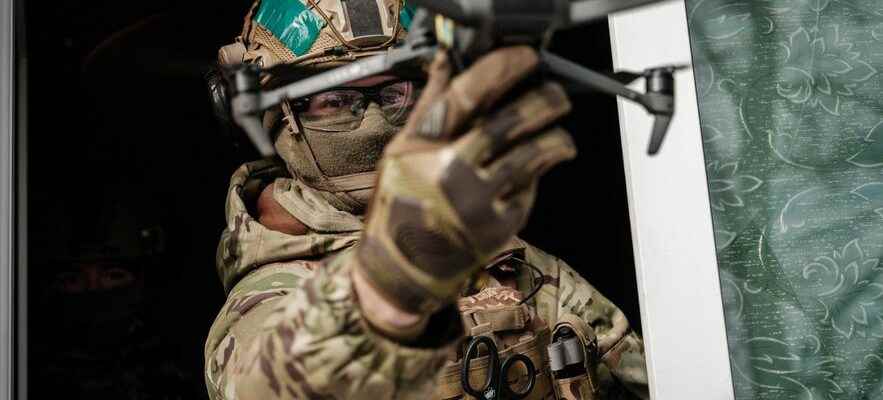The 61st artillery regiment will finally be able to fly its big white bird. This unit specializing in the use of drones will receive in the coming weeks its first “Patroller” on its base in Chaumont-Semoutiers (Haute-Marne), after the certification granted to the device, mid-February, by the General Management of armament. Since October, the copy in his hands still belonged to the industrial Safran and was only used, for the moment, to train maintenance personnel. A few meters away, the pilots had to make do with simulation flights on the control station loaned by the manufacturer.
With a wingspan of 18 meters, capable of flying at 200 km/h for about fifteen hours and up to 7,500 meters above sea level, the Patroller has characteristics similar to the famous Bayraktar TB2. Like the latter, it will be able to carry out intelligence, surveillance and targeting missions, thanks to state-of-the-art sensors. But unlike the bestseller from Turkey – more than 300 orders, for sales to some twenty countries – the 14 Patrollers that the Army should receive within three years are not programmed to fire missiles themselves.
Nothing surprising in this failure: France has always been behind on its drones, despite the explosion of their military use over the past two decades. The next military programming law 2024-2030 aims precisely to fill the existing gaps. To the great relief of Safran, which hopes to export some, the Patroller should be able to carry weapons. But it will not be for now: from development to certification, a few years will be necessary before the 61st artillery regiment can place missiles under its own.
Two decades behind the United States
“We completely missed the turn of the drones,” laments Senator Cédric Perrin (Les Républicains), author of several reports on the subject. This is particularly the case for medium-altitude drones, which are even larger than Patrollers. The Air Force had to wait until 2014 to have its first reconnaissance capabilities, with the purchase of American Reapers. Armed since 2019, they now represent the majority of French airstrikes in the Sahel.
Still, France got there two decades behind the United States. “The subject was under consideration, but time was lost in debates on the armament of drones, now swept away, while the more compact format of the Air Force gave priority to the Rafale”, recalls General Patrick Lefevbre, director of the Mediterranean center for strategic studies at the FMES institute.
The successor to the Reaper in the French army, the Eurodrone (30 meter wingspan, 10 tons), the result of cooperation with Germany, Italy and Spain, should only enter service at the end of the decade, five years late. “But it risks being obsolete, because then we could no longer be in asymmetrical conflicts like in the Sahel, fears Cédric Perrin. At the moment, we could not fly the Eurodrone over Ukraine, because it would be destroyed by anti-aircraft defences. The current war shows that it is necessary to go for low-cost, easily expendable drones. The priority is prowling ammunition.”
A Ukrainian soldier prepares to launch a drone equipped with a grenade in Bakhmout, February 9, 2023.
© / AFP
France has… none. To make up for this delay as quickly as possible, it has decided to acquire this year “kamikaze drones” already available on the market, according to an emergency procedure, for its special forces. His choice should be 72 Switchblade 300, an American model the size of a loaf of bread, which has proven itself in Ukraine. The relay should then be taken over by ammunition with a range of 5 and 50 km, the development of which has been entrusted to French industrialists – the COLIBRI and LARINAE projects – to have a sovereign capacity. The Minister of the Armed Forces, Sébastien Lecornu wishes “to have several thousand” by the end of the decade.
In the meantime, deliveries of unarmed equipment are going well. 2,000 aircraft have already been delivered in 2022. “The objective is to consolidate so that all units deployed in operation or training are equipped by 2025, explains Lieutenant-Colonel Pierre-Yves, specialist drones to the army staff. We are in the process of equipping each tactical echelon with a suitable system, with increasing size and performance depending on the level considered.”
In the future, an infantry section – one officer, seven non-commissioned officers and around twenty soldiers – will have to be systematically equipped with a system with a nano reconnaissance drone like the Black Hornet (2 km range), which is the size and weight of a titmouse. “A company (hundreds of soldiers) must be able to be accompanied by a surveillance micro-drone weighing less than two kilos (NX70 and Anafi), a battalion must have the support of a mini-drone system. SMDR drone (15 kg, 2h30 autonomy, 30 km range), “says Lieutenant-Colonel Pierre-Yves. Each system should include a control station and two to three aircraft for recharging rotations.”
Faced with anti-drone actions, the lifespan of these small aircraft – most of the time purchased from the civilian sector and reconditioned – is however very short. A report by the British Rusi analysis center found that 90% of the drones used by the Ukrainians in the first months of the current conflict had been lost. A lesson to be learned for France: “We have not yet set up production capacities to produce large volumes”, points out Cédric Perrin. In the event of a major engagement, France could therefore quickly find itself running out of drones.
